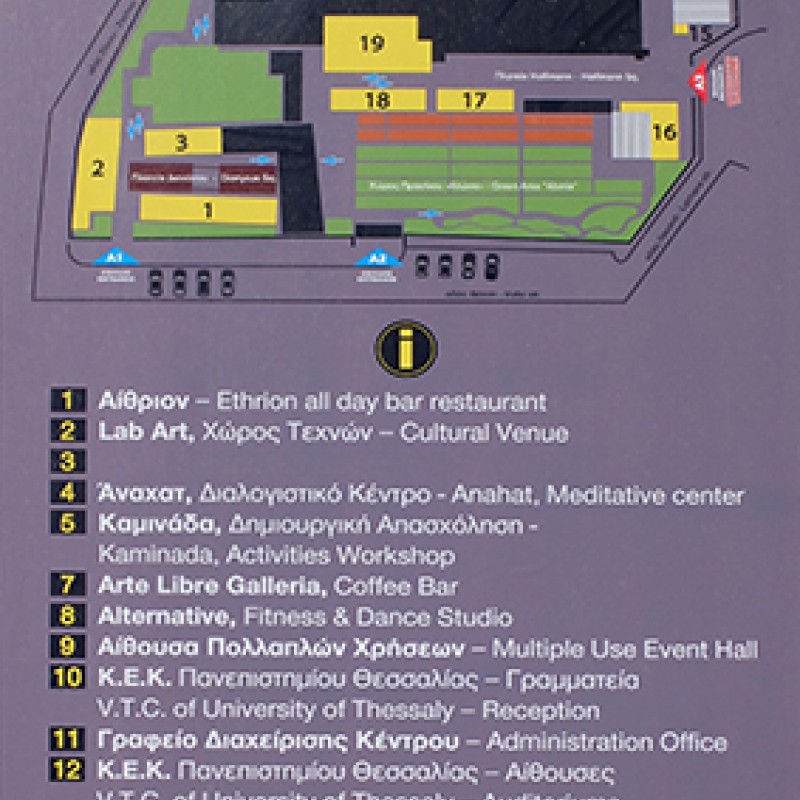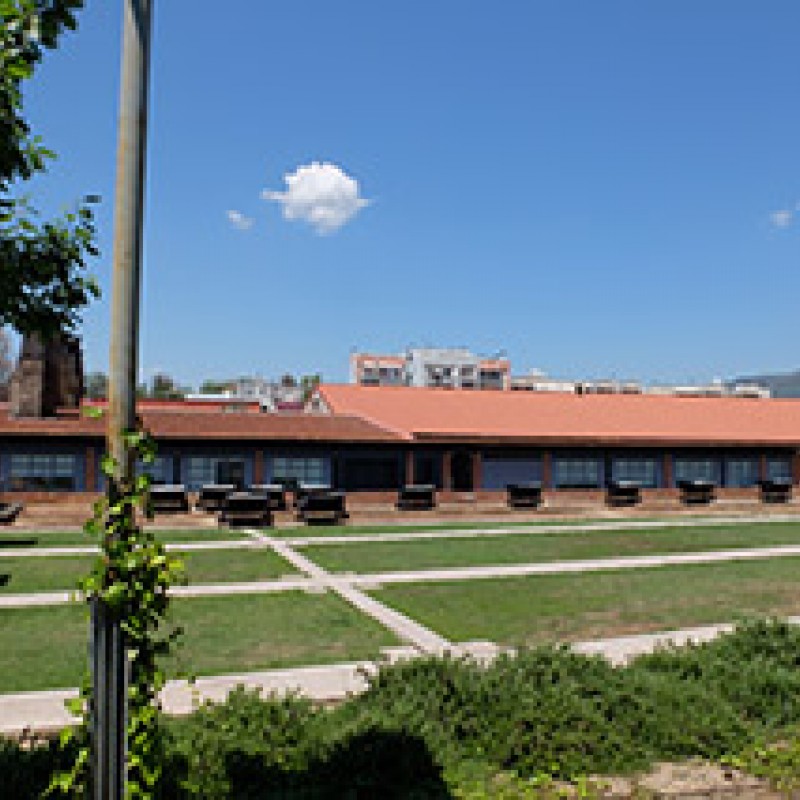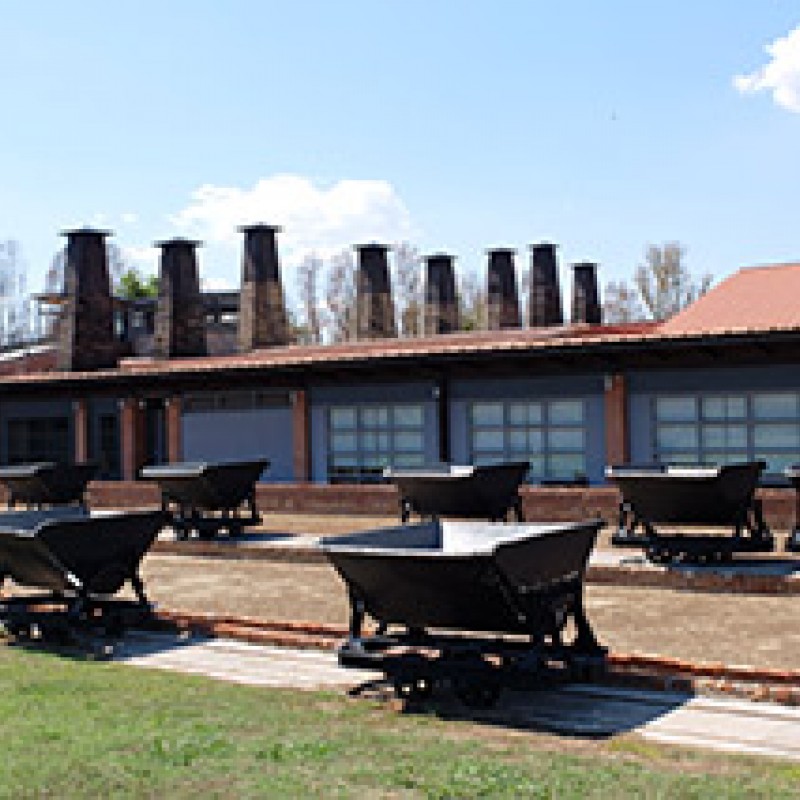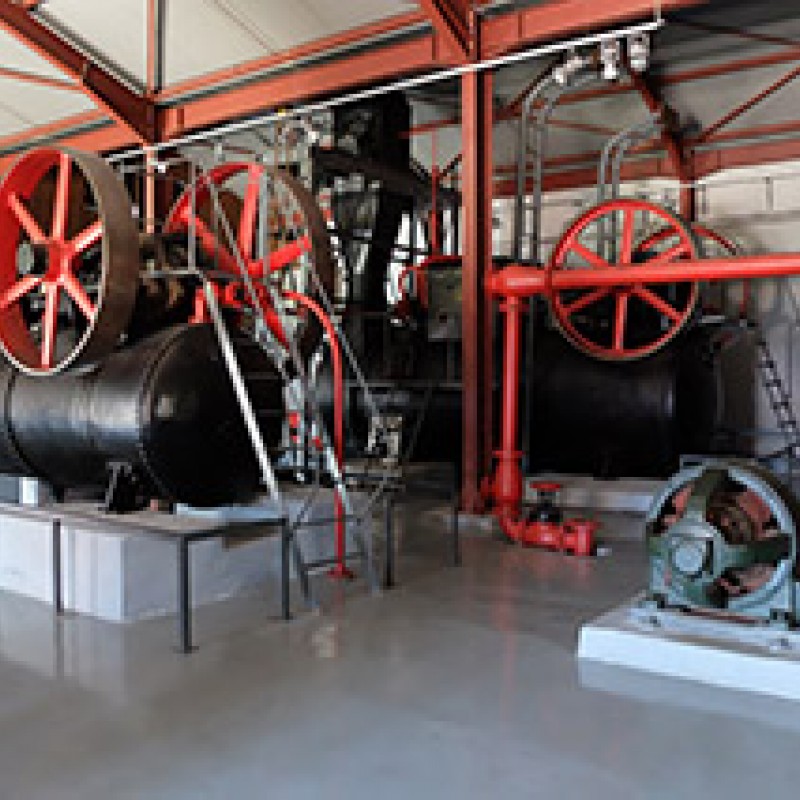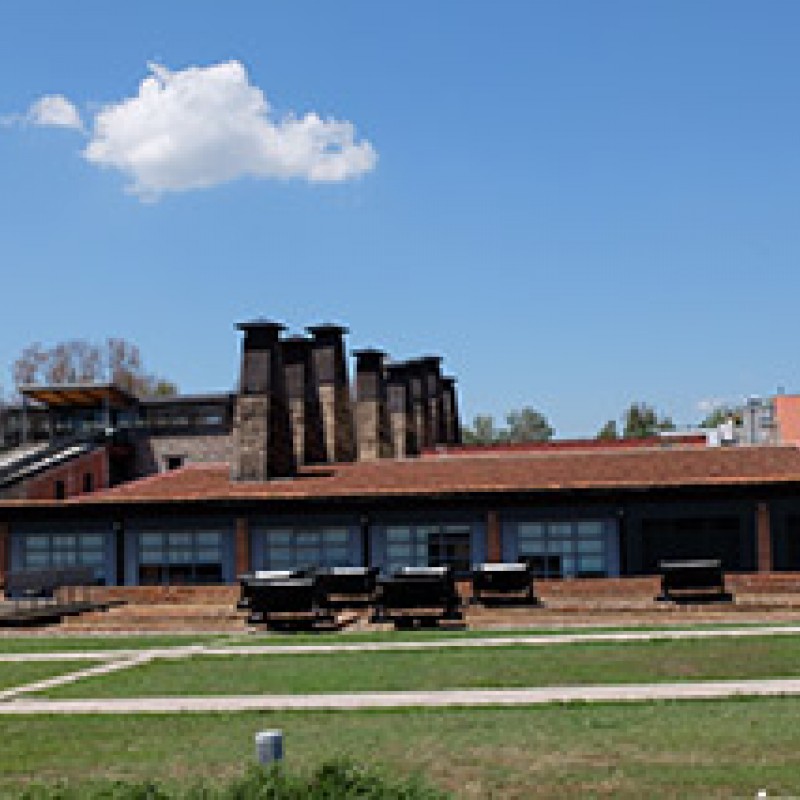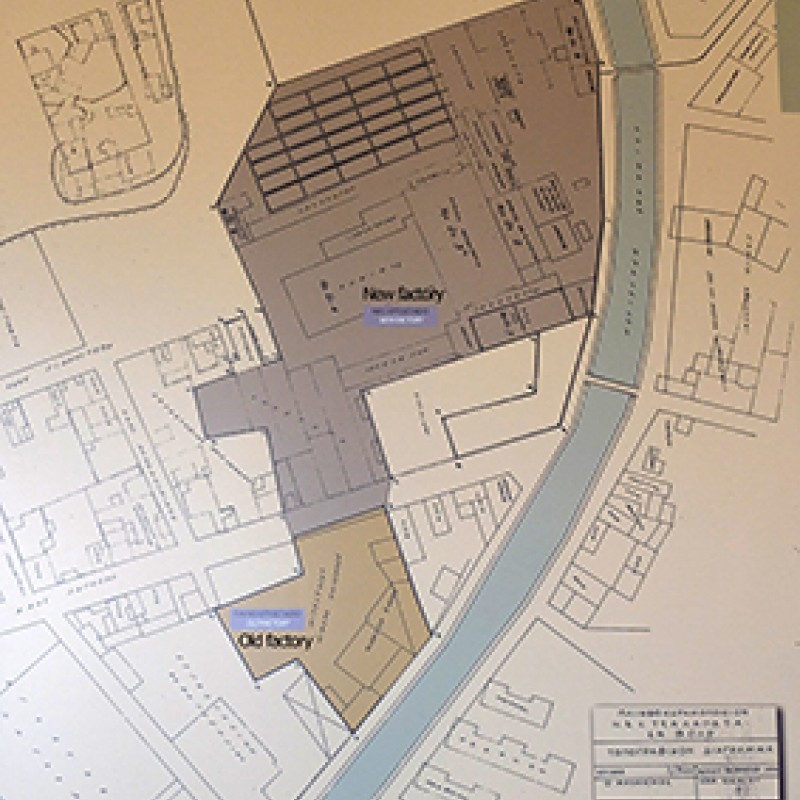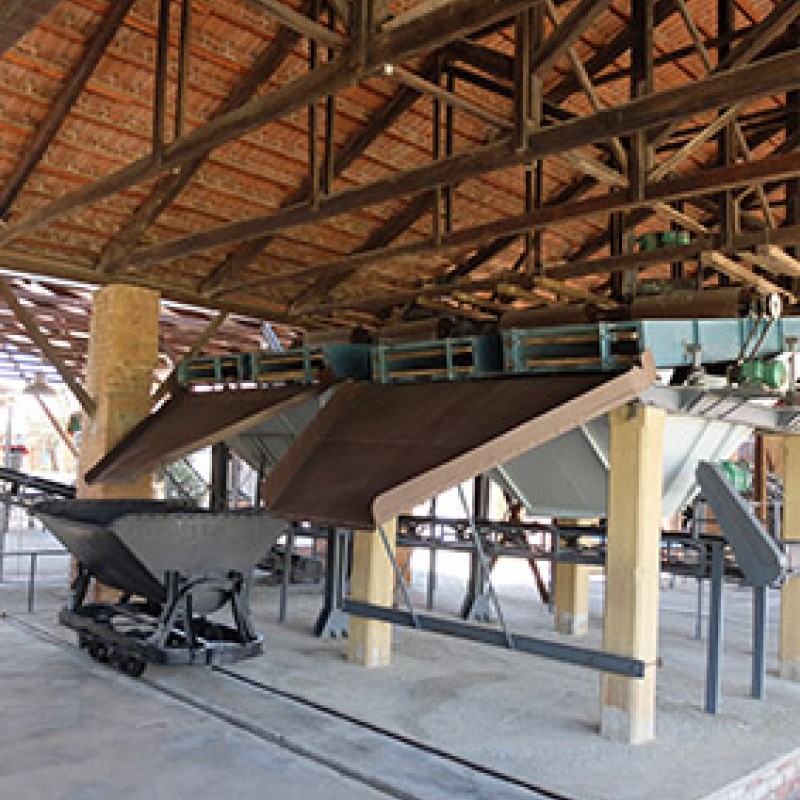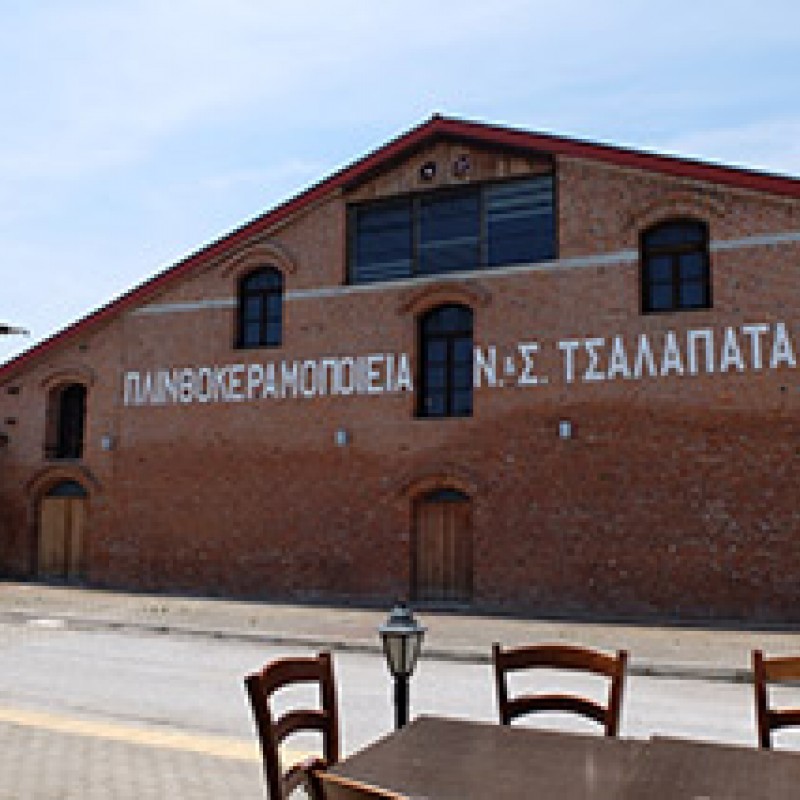Tsalapatas complex
Notia Pyli , Volos 383 34, Greece
| Former Use: | Rooftile and Brickworks factory | 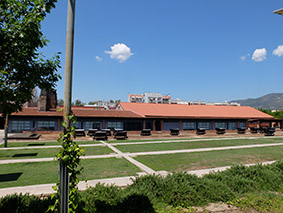 |
| New Use: | Roof tile and Brickworks Museum N. & S. Tsalapatas, bars, restaurants, offices of the University of Thessaly services | |
| Category: | Culture, HoReCa, Industrial Museum, Office, Recreation | |
| Website: | http://www.piop.gr/en/diktuo-mouseiwn/Mouseio-Plinthokeramopoieias-Tsalapata/to-mouseio.aspx | |
| Reuse Architect: | Kizis architects | |
| Construction year(s): | 1924 - 1928 | |
| Reuse year(s): | 2007 - |
Description:
Historic use
The Rooftile and Brickworks factory of N. & S. Tsalapatas is located in Volos, one of the most important industrial centres of the Greek periphery in the late 19th and early 20th century. The first installations of the factory were built in 1917, next to the stream Kravsidonas, at the location “Palia”, where other similar industrial activities were set, too. With the development of the city along the course of time, the context of the factory changed. Today, the historic factory is positioned at the northwest entrance of the city of Volos, in a loosely developed area neighbouring with housing, sports facilities and empty plots.
In 1924, the factory was extended with the construction of a new, bigger and more modern facility in a neighbouring plot. The works took place in two phases (1924-1926 and 1928) and were overseen by two Belgian engineers of the company Sabbe et Steenbrugge. The same company supplied and installed the largest part of the factory’s machinery. The old factory remained operational up to 1956, functioning complementary in the busy periods while serving as as a storage unit and a stable for the rest of the time. A connection between the old and the new installations was established with a railway line. The main products of the plant included bricks of several typologies, French and Greek type rooftiles, gutters and clay pipes.
The factory stopped temporally its operation during the German occupation and reopened after the liberation. From 1954-1956 it sustained severe damages caused by earthquakes and a flood. The extent of the damages required a new four-month pause of operations for repairing the premises. Since 1960, upon the electrification of the company, the owners modernised the mechanical equipment of the factory, building in parallel new drying facilities. Despite these changes, the company was not able to cope with the wide changes in the demand of building materials and the rising competition and as a result the factory ceased operations in 1978. (Piraeus Bank Group Cultural Foundation, 2009, 29-42)
Reuse Preparation
The closure of Tsalapatas factory cannot be seen just as an isolated incident but it should be placed against the general industrial decline in Volos between WWII and the 1980s. According to K. Adamakis, (2007, 182) 54 big industrial complexes lost their function in that period, leaving a series of black holes across the city’s urban tissue.
In contrast with the standing practice of that time in Greece, the large majority of the obsolete factories did not fall prey to an ill-conceived modernisation. Under the initiative of the local administration and the newly established University of Thessaly, a plan for their preservation and reuse was developed and executed with funds from the EU programme URBAN and national resources. (Adamakis, 2007, 179-199)
Within the framework of this plan, the municipality of Volos purchased a number of historic industries, including the complex of N. & S. Tsalapatas. The complex attracted the C.C.’ s attention due to its historic role, its key location in the city and its state of maintenance. (Adamakis, interview, 1/6/2017) In detail, albeit its long period of vacancy, the complex was in a very good condition when passed into the hands of the local authority in 1994-95.
This was confirmed by M. Stratton, Director of the Ironbridge Gorge Museum, who evaluated it, upon the request of the Municipality in 1994. The expert documented the complex and its technical content. In his report “Tsalapatas Tile Works and the potential for heritage tourism, Volos, Greece,” (November 1994) he concluded that the factory was preserved very well retaining all its installations, including the Hoffmann Kiln and the full extent of its machinery, from its establishment to its electrification. He also proposed the listing of the complex and formed an initial scenario for its conversion into a museum. (TICCIH Greece, 1995, 16-17)
In 1995 the building premises of the complex were listed as a national monument by the Ministry of Culture. (Panagiotakopoulos et al., 2003, 88) According to E. Dimoglou, (1998, 40-41), the initial idea for the new use of the former industry was the creation of an industrial museum interpreting the former function of the factory in combination with a museum of the industry of Volos, a documentation centre of the local industry, exhibition and event halls, workshops for applied arts and a vocational training centre for the preservation of industrial heritage. For the realisation of that vision a multidisciplinary team was formed.
As I. Kizis explains,(1999, 27) the years that followed saw the fate of the former factory flirting multiple times both with well thought and with destructive prospects. A key issue that caused these fluctuations was the indecisiveness of the local authority during the process of decision making, which left the historic industry exposed to compromising ideas and practices.
Between 1995 and 1998 a series of opposing decisions shaped the future of Tsalapatas factory. Firstly, the initial programme scenario was modified, incorporating apart from the functions of the museum and the workshops, cultural, commercial and recreational dimensions, too. Secondly, the preliminary study for the conversion of the site was assigned to the team of engineers of the Municipal Research Company (ΔΕΜΕΚΑΒ) . The team, overseen by three experts in the field of conservation, prepared a respectful proposal that was meeting the requirements of the EU program URBAN which would finance the project.
Nevertheless, before the beginning of the works, a new idea, based on the principles of energy efficient design, was introduced. According to Kizis, (1999,28) the new interventions proposed were totally incompatible, compromising the cultural values of the industrial venue. This last development became an apple of discord between the stakeholders and resulted in the withdrawal of a big part of them. Finally, amidst a setting of political conflict, the C.C. approved a patchwork study which “strived to connect erratic and unrelated ideas” (Kizis, 1999,28)
Reuse process
The reuse of the Tsalapatas factory was realised in two phases taking place from 1998 to 2001 and from 2004 to 2006. The conversion approach between these two phases presents a lot of differences, providing insights into the development of intervention practice on industrial heritage in Greece in the turn of the 21st century.
According to various testimonies (interviews A. Louvi, Y. Kizis, A Dimoglou) and articles (Kizis, 1999, Louvi, 2006), the first phase of the reuse, realised by inexperienced constructors and overseen by the services of the Municipality of Volos, had a destructive impact to the integrity of the complex. E. Dimoglou, historian (interview, 1/6/2017) states:
“The study of the Municipality included the construction of new buildings. As a result various parts of the complex and its mechanical equipment (grinding mills, furnaces) were sacrificed to leave space for those, while the machine shop was guttered. The Service of Modern Monuments tried to protect the complex, but finally the works proceeded after the intervention of the Central Council of Modern Monuments (ΚΣΝΜ)”
Apart from the aforementioned actions, several wooden sheds were also demolished during that phase, while an important part of tools, mechanical equipment, products’ packaging and transportation components was lost. The interventions in the preserved buildings were invasive and irreversible including in several parts demolitions of wooden elements and substitution of stone and brick walls with concrete ones. (Kizis, 1999,28-29)
The conversion finished in 2001 but it was not opened to the public. A few years later the Municipality organised a bidding tender for finding an investor who would complete the construction of the core and the context of the complex and a cultural organization that would take on the museological and museographic integration of the brickworks museum in the core of the factory. The company ΓΕΚ was chosen for the first task, while the Piraeus Bank Group Cultural Foundation (PBGCF) undertook the second task.
The second phase of the complex’s conversion started in 2004 and employed a contrasting approach from the first phase. The conversion of the main core of the factory in a museum of itself was implemented with respect to its historical, technical and cultural values. No further demolitions nor key alterations took place. In contrast, a conscious effort was made to safeguard all the existing elements and interpret them to the public. Y. Kizis, the architect who undertook the design of the complex notes:
“I tried to restore where possible what I had seen in the early 1990s. I tried to give the old character to the building based on photographs I had taken and material from the contractor.
I chose to introduce a slightly different architectural language to differentiate the additions from the original fabric.” (interview, 16/6/2017)
The sub-project of the commercial, cultural and recreational part was funded by ΓΕΚ while Piraeus Bank funded the creation of the museum. According to A. Louvi, Director of the PBGCF (interview, 7/6/2017), this was not a standard practice followed for the projects of the PBGCF.
“It is the only museum of the PBGCF network financed by the Bank. It was an exception to the rule because the Municipality had already received an EU funding and it had destroyed the complex”
Apart from the technical difficulties in reversing the damages of the previous phase and the challenges of securing enough funds for the implementation of the museum, there were also complications in the collaboration between ΓΕΚ and PBGCF. (Louvi, 2006, 54-55) All these issues, along with a flood of the complex in November 2006, delayed its opening nine months and multiplied the conversion costs.
Operation
Tsalapatas complex opened in 2007, offering a diverse mixed use program to the public. 6.000m2 of mainly new-built constructions housed commercial, cultural and leisure facilities while the main core of the historic complex (5.000 m2) housed the Rooftile and Brickworks Museum of N. & S. Tsalapatas. The management and exploitation of the complex was granted by the Municipality of Volos to the two organisations implicated in the second phase of the complex’s reuse, for a period of 50 years.
The museum, prepared by the experienced team of the PBGCF in collaboration with Y. Kizis, (architectural design), V. Kolonas (museological and museographic study) and the mechanical engineer S. Chatzigogas (machinery conservation and scale models creation) is an impressive space of high aesthetical, historic, educational and technical significance. Based on a comprehensive research and careful conservation work, it narrates both the history of the factory and the production process. The exhibition route follows the production line, casting special attention to the preserved mechanical equipment of the factory. The museum also offers information about the factory’s personnel, its products and the rooftile and brickworks production sector in Greece.
The part run by IOLKOS (the managing company established by ΓΕΚ) in the first years of operation focused on leisure and HORECA activities including, restaurants, cafes, bars and night clubs, organising also music and theatre events. From the outset, that commercial part and the audience it attracted clashed with the cultural vision of the museum, aggravating the tension between IOLKOS and PBGCF. This development played a very negative role in the operation of the complex. As E. Dimoglou, (interview, 1/6/2017) puts it:
“The problem is that the new managers did not get along in order to create a common framework. They did not organise common actions, at least in the first years.”
As a result the project did not have the expected resonance from the public. A . Louvi (interview, 7/6/2017), commending on the potential of the case states:
“It was the biggest industrial museum in the network of PBGCF. In the beginning we were envisioning it as the diamond of the chain. Unfortunately, this aspiration was not met because of the co-existence with the investor, which had a detrimental effect on the attraction of visitors for the museum.”
Shifts
Very shortly after the opening of Tsalapatas complex, Greece fell into financial crisis, a development that influenced deeply the operation of the commercial part of the project. A big percentage of the spaces for hire were left vacant forcing IOLKOS to adjust both the rent and its activities. (Chanou, 2015) Since 2009, the University of Thessaly became a tenant of the complex while gradually the focus of IOLKOS shifted from the night leisure activities to family friendly functions.
E. Manioti, manager of Tsalapatas commercial section, (interview, 1/6/2017) elaborating on the shifts taking place, notes:
“The past couple of years we have all our spaces hired, apart from one. Because of the differentiation of the functions, some spaces are operational at night and others during the day. Now we have the same percentage of day and night activities.[…] We host events from 5 to 5000 people. In recent years we have been organising a lot of events for families and children. In the early years of our operation we were focusing more on the adults, organising music and theatre happenings. We adjust to the changing situation. Our choices are influenced by the trends of each period...”
According to the statements of the museum’s personnel and E. Manioti during the qualitative research of this dissertation (interviews, June 2017), the rising tension between the two involved organisation has been reduced and there are also plans for some common actions.
Relevant Literature:
- Adamakis, K. Critical evaluation of the reuse of industrial buildings in Volos. Proposals for the following day. In: Municipal Center for Historical Research and Documentation of Volos , ed. The end of giants: Industrial heritage and urban transformations, 22-25 November 2007 Volos. 179-199.
- Chanou, E. 2015. The neighborhood of Tsalapatas gets desolated. Tachidromos, 26 December.
- Dimoglou, E. 1998. Proposal for the creation of an industrial museum in the Rooftile and Brickworks factory Tsalapatas Technologia: Bulletin of the Cultural Technological Foundation of the Hellenic Industrial Development Bank, 40-41.
- Kizis, Y. 1999. The Rooftile and Brickworks factory Tsalapatas. The industrial heritage of Volos and its recent destiny. Technologia: Bulletin of the Cultural Technological Foundation of the Hellenic Industrial Development Bank, 26-29.
- Louvi, A. 2006. The Rooftile and Brickworks museum of N. & S. Tsalapatas En Volo, 52-57.
- Panagiotakopoulos, N., Sgouris, V. & Sismanis, G. 2003. The Rooftile and Brickworks factory Tsalapatas En Volo, 88-93.
- Piraeus Bank Group Cultural Foundation 2009. The Rooftile and Brickworks factory of N. & S. Tsalapatas (1917-1978), Athens, Piraeus Bank Group Cultural Foundation.
- TICCIH Greece 1995. The Rooftile factory Tsalapatas in Volos. TICCIH Greece Bulletin, 16-17.
